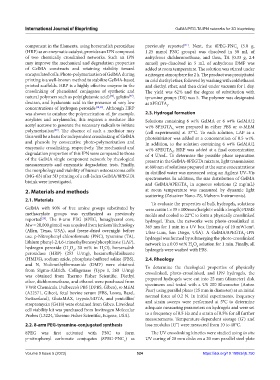Page 532 - IJB-9-5
P. 532
International Journal of Bioprinting GelMA/PEG-TA IPN networks for 3D bioprinting
component in the filaments, using horseradish peroxidase previously reported . Next, the 8PEG-PNC (5.0 g,
[41]
5
(HRP) as an enzymatic catalyst, provides an IPN composed 1.25 mmol PNC groups) was dissolved in 50 mL of
of two chemically crosslinked networks. Such an IPN anhydrous dichloromethane, and then, TA (0.33 g, 2.4
may improve the mechanical and degradation properties mmol) pre-dissolved in 5 mL of anhydrous DMF was
of GelMA constructs and retaining viability toward added at room temperature. The solution was stirred under
encapsulated cells. Photo-polymerization of GelMA during a nitrogen atmosphere for 2 h. The product was precipitated
printing is a well-known method to stabilize GelMA-based in cold diethyl ether, followed by washing with cold ethanol
printed scaffolds. HRP is a highly effective enzyme in the and diethyl ether, and then dried under vacuum for 1 day.
crosslinking of phenolated conjugates of synthetic and The yield was 62% and the degree of substitution with
natural polymers such as poly(glutamic acid) , gelatin , tyramine groups (DS) was 5. The polymer was designated
[36]
[37]
dextran, and hyaluronic acid in the presence of very low as 8PEGTA .
concentrations of hydrogen peroxide [38,39] . Although HRP 5
was shown to catalyze the polymerization of, for example, 2.3. Hydrogel formation
acrylates and acrylamides, this requires a mediator like Solutions containing 6 wt% GelMA or 6 wt% GelMA/2
acetyl acetone to generate the necessary radicals to initiate wt% 8PEGTA were prepared in either PBS or a-MEM
5
polymerization . The absence of such a mediator may (cell experiments) at 37°C. To each solution, LAP as a
[40]
thus well be a basis for independent crosslinking of GelMA photoinitiator was added at a concentration of 0.5 wt%.
and phenols by consecutive photo-polymerization and In addition, to the solution containing 6 wt% GelMA/2
enzymatic crosslinking, respectively. The mechanical and wt% 8PEGTA , HRP was added at a final concentration
degradation properties of this IPN were compared to those of 4 U/mL. To determine the possible phase separation
5
of the GelMA single component network by rheological present in the GelMA-8PEGTA mixture, light transmission
measurements and enzymatic degradation tests. Finally, at 680 nm of solutions prepared at the same concentrations
the morphology and viability of human osteosarcoma cells in distilled water was measured using an Agilent UV–Vis
(MG-63) after 3D printing of a cell-laden GelMA/8PEGTA spectrometer. In addition, the size distribution of GelMA
bioink were investigated.
and GelMA/8PEGTA in aqueous solutions (2 mg/mL)
5
2. Materials and methods at room temperature was measured by dynamic light
scattering (Zetasizer Nano-ZS, Malvern Instruments).
2.1. Materials
To evaluate the properties of bulk hydrogels, solutions
GelMA with 90% of free amine groups substituted by were cast in 1 × 35 × 100 mm (height × width × length) PDMS
methacrylate groups was synthesized as previously molds and cooled to 22°C to form a physically crosslinked
reported . The 8-arm PEG (8PEG, hexaglycerol core, hydrogel. Then, the networks were photo-crosslinked at
[20]
Mw = 20,000 g/mol) was acquired from Jenkem Technology 365 nm for 1 min in a UV box (intensity of 10 mW/cm ,
2
(Allen, Texas, USA), and freeze-dried overnight before Ultra-Lum, San Diego, USA). A GelMA/8PEGTA -IPN
5
use. p-Nitrophenyl chloroformate (PNC), tyramine (TA), hydrogel was formed by submerging the photo-crosslinked
lithium phenyl-2,4,6-trimethylbenzoylphosphinate (LAP), network in a 0.03 wt% H O solution for 1 min. Finally, all
2
2
hydrogen peroxide (H O , 30 wt% in H O), horseradish hydrogels were washed with PBS.
2
2
2
peroxidase (HRP) (253 U/mg), hexamethyldisilazane
(HMDS), sodium azide, phosphate-buffered saline (PBS), 2.4. Rheology
and N, N-dimethylformamide (DMF) were obtained To determine the rheological properties of physically
from Sigma-Aldrich. Collagenase (Type I, 260 U/mg) crosslinked, photo-crosslinked, and IPN hydrogels, the
was obtained from Thermo Fisher Scientific. Diethyl prepared hydrogels were cut into 25 mm (diameter) disk
ether, dichloromethane, and ethanol were purchased from specimens and tested with a US 200 Rheometer (Anton
VWR Chemicals. Dulbecco’s PBS (DPBS, Gibco), a-MEM Paar) using parallel plates (25 mm in diameter) at an initial
(A22571, Gibco), fetal bovine serum (FBS, Lonza, Basel, normal force of 0.2 N. In initial experiments, frequency
Switzerland), GlutaMAX, trypsin/EDTA, and penicillin/
streptomycin (G418) were obtained from Gibco. Live/dead and strain sweeps were performed at 5°C to determine
cell viability kit was purchased from Invitrogen Molecular adequate measuring parameters on hydrogels and were set
Probes (L3224, Thermo Fisher Scientific, Eugene, USA). to a frequency of 0.5 Hz and a strain of 0.5% for all further
measurements. Temperature-dependent storage (G’) and
2.2. 8-arm PEG-tyramine-conjugated synthesis loss modulus (G”) were measured from 10 to 40°C.
8PEG was first activated with PNC to form The UV crosslinking kinetics were studied using in situ
p-nitrophenyl carbonate conjugates (8PEG-PNC ) as UV curing of 20 mm disks on a 20 mm parallel steel plate
5
Volume 9 Issue 5 (2023) 524 https://doi.org/10.18063/ijb.750

